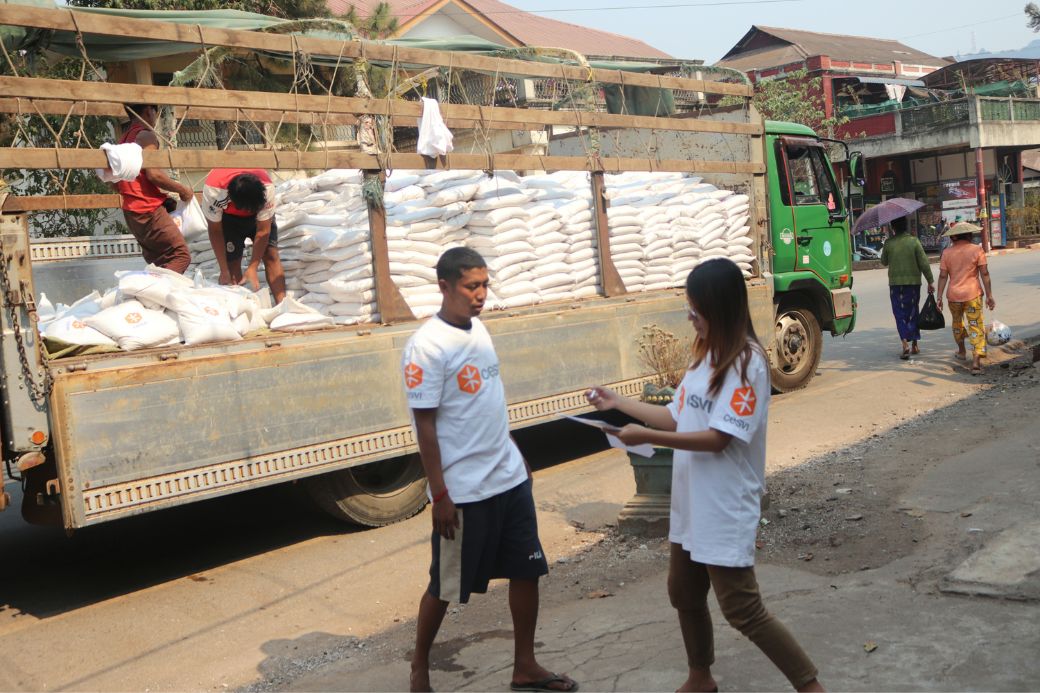Just over two weeks after the devastating earthquake that struck Myanmar – where a new strong earthquake of magnitude 5.6 was recorded on Sunday 13 April, 34 km away from Meiktila, Mandalay – we at CESVI have been on the front line since the outbreak of the emergency to provide crucial humanitarian assistance to the most vulnerable populations. Despite the very difficult situation and the complexity of organising supplies and travel to the most remote areas, the CESVI team was immediately activated by carrying out several analysis and monitoring visits and meeting directly with the population in the affected areas in the very first days. At the beginning of April in record time we delivered the first aid shipment of 1,500 5kg bags of rice and last week the first cargo plane of aid arrived from Malaysia, thanks to the EU Humanitarian Air Bridge.
Donate now to support CESVI’s intervention in Myanmar.
Two CESVI truckloads of aid, donated by the European Union, are currently on their way to the southern Shan areas, with the primary objective of reaching the communities that have not yet received any support. We also plan to extend our action to other severely affected regions. In the coming days and weeks, we will distribute essential goods to at least 3,520 families as follows: 920 families in Southern Shan, 1,250 families in Mandalay, 1,250 families in Sagaing and 100 families in the Nay Pyi Taw region. We estimate that our intervention will reach about 15,100 people.
Widespread humanitarian emergency: over two million people in need
The scale of the humanitarian crisis in Myanmar is alarming. OCHA (United Nations Office for Humanitarian Affairs) estimates that more than two million people are in urgent need of assistance. This is in addition to the approximately 20 million Burmese who were already in a vulnerable condition before the earthquake, highlighting an already critical pre-existing situation that has been further exacerbated by the natural disaster.
New displacements and the need for safe shelter.
The earthquake caused a significant number of new displacements, estimated at around 200,000 people (AHA Centre). These people are mostly in makeshift shelters, often inadequate to provide effective protection. The need for tents and safe structures to shelter them is therefore an urgent priority to provide them with decent living conditions and protection from the elements.
Massive housing damage and landmine hazards
The consequences of the earthquake on the housing infrastructure are devastating. The latest estimates indicate that over 50,000 houses have been damaged or completely destroyed. Added to this is the constant danger of aftershocks, which could cause further collapses and jeopardise the safety of the population. A further complication is the presence of landmines in many of the worst affected areas. The earthquake inadvertently moved these devices, exposing fleeing families to the terrible risk of explosions.
Poor sanitation and threat of disease
Living conditions for many survivors are extremely difficult. Many families are forced to sleep outdoors, exposed to extreme heat and seasonal rains. This situation significantly increases the risk of contracting mosquito-borne diseases such as dengue and malaria. In addition, water systems have suffered severe damage. The lack of functioning wells and damaged pipes have left entire communities without access to clean water. As a result, there is growing concern about the spread of infectious diseases, exacerbated by improper handling of corpses and lack of proper sanitation facilities.
The situation in Myanmar requires immediate and coordinated humanitarian intervention. Also thanks to the EU’s support, CESVI is on the ground providing essential aid and assistance to affected communities.
Any help is vital to support these communities that have lost everything. Donate now.
